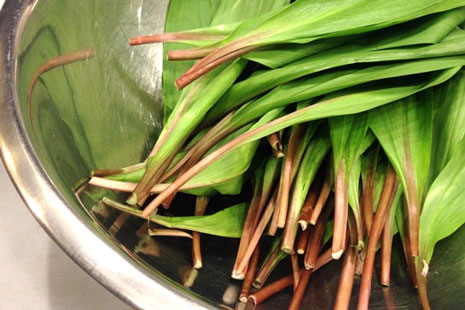
“Very few people recognize it,” says Mary Carpenter of Violet Hill Farm. She is talking about the Japanese knotweed that she sells at Union Square Greenmarket in April. “The ones that do usually have negative feelings towards it,” she says.
That is because the plant is aggressive. Beyond its East Asian home, Japanese knotweed grows in dominating colonies whose relationship with humans is on a war footing: uprooted with backhoes (but tiny left-behind pieces take root), spraying (at significant financial and environmental cost) and mowing (depleting the plants’ energy enough to control the stands, but not destroy them).
But the weed has a secret, softer side: it is a very appealing vegetable. While most people compare it to rhubarb (Mary: “my kids love it”) it also has vast savory potential, because it is very tart. Most of my own recipes for it belong to the salty side of the flavor spectrum. The educational curve is steep, though; even chefs, says Mary, use it only “in small portions” every season. It is a problem of recognition. But I have no doubt that the social mediasphere will light up with #japaneseknotweed this #foraging spring.
Until recently knotweed was not a commodity. I used to daydream of flocks of farmers and foragers slicing the fat shoots, bundling them like the asparagus they resemble, and marching them to market. Tentatively, this has begun. Will the trickle become a tide?
Farmers like Mary tap into a revived appetite for new flavors. While her focus is meat (pigs, chicken and turkey), her market knotweed comes from a neighboring property in Herkimer County and she drives it to the city (four hours each way) with her other products while its season lasts. More edible “weeds” follow: upland cress, nettle, garlic mustard, burdock roots and stalks, chamomile, pineapple weed, amaranth, broadleaf plantain, grape leaves, red clover, watercress, lamb’s quarters and common milkweed buds, flowers and pods. Other Union Square Greenmarket vendors like Lani’s Farm (New Jersey), sell elusive (at least in kitchens) spring pokeweed shoots, which must be blanched before eating. They are a choice American vegetable. Lani’s also sells chickweed, wild dandelions, ramps, lambs quarters, and mugwort. Paffenroth Gardens sells invasive field garlic.

“There is money to be made in many things that people find worthless,” says Mary. If your (previously) worthless thing is a toothsome crop that has looked after itself gratis all year, if its harvesting replicates or replaces mechanical and chemical control, and if it generates income, there are three compelling reasons to sell, and eat, your weeds.
Japanese knotweed shoots with mozzarella
Use fat shoots that are very tender to slice. Here a quick pickle—no need for acid—tops creamy mozzarella.

2 Japanese knotweed shoots, about 8” long
1 teaspoon salt
2 teaspoons sugar
1 ball of fresh mozzarella or burrata
1 Tablespoon hickory or walnut oil
Black pepper
Slice the Japanese knotweed shoots into rounds, discarding the tougher joints in the stem. Put the rounds in a bowl and add the salt and sugar. Massage well. Let the knotweed sit for 30 minutes. Rinse and dry the knotweed and scatter the rounds across the sliced mozzarella. Dress with hickory or walnut oil. Season with some cracked pepper.



